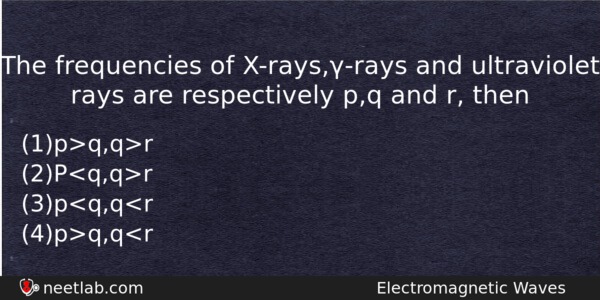| ⇦ | 
| ⇨ |
The frequencies of X-rays,γ-rays and ultraviolet rays are respectively p,q and r, then
Options
(a) p greater than q,q greater than r
(b) p less than q,q greater than r
(c) p less than q,q less than r
(d) p greater than q,q less than r
Correct Answer:
p less than q,q greater than r
Explanation:
No explanation available. Be the first to write the explanation for this question by commenting below.
Related Questions: - The temperature of ideal gas is reduced from 927° C to 27° C. The r.m.s velocity
- A charged particle enters a uniform magnetic field with a certain speed at right angles
- The wavelength of first line of Balmer series is 6563Å. The wavelength of first line
- A capacitor is charged to 200 volt. It has a charge of 0.1 coulomb.
- A particle has initial velocity (2i⃗+3j⃗) and acceleration (0.3i⃗+0.2j⃗). The magnitude
Topics: Electromagnetic Waves
(28)
Subject: Physics
(2479)
Important MCQs Based on Medical Entrance Examinations To Improve Your NEET Score
- The temperature of ideal gas is reduced from 927° C to 27° C. The r.m.s velocity
- A charged particle enters a uniform magnetic field with a certain speed at right angles
- The wavelength of first line of Balmer series is 6563Å. The wavelength of first line
- A capacitor is charged to 200 volt. It has a charge of 0.1 coulomb.
- A particle has initial velocity (2i⃗+3j⃗) and acceleration (0.3i⃗+0.2j⃗). The magnitude
Topics: Electromagnetic Waves (28)
Subject: Physics (2479)
Important MCQs Based on Medical Entrance Examinations To Improve Your NEET Score
18000+ students are using NEETLab to improve their score. What about you?
Solve Previous Year MCQs, Mock Tests, Topicwise Practice Tests, Identify Weak Topics, Formula Flash cards and much more is available in NEETLab Android App to improve your NEET score.
Share this page with your friends

frequency of uv rays(r)=10^16 Hz to 10^17 Hz
frequency of x-rays(p)=10^18 Hz to 10^20 Hz
frequency of gamma-rays(q)=10^18 Hz to 10^22 Hz
therefore, p is less than q and q is greater than r.